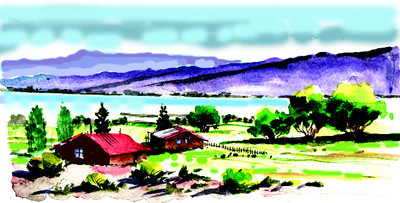Pahranagat Valley features some of the best Lincoln County has to offer

Neighboring Lincoln County’s scenery, history, picturesque towns and varied outdoor recreation make it a good choice for outings most of the year. Lying just 90 miles north of Las Vegas, scenic Pahranagat Valley offers a sampling of Lincoln County’s attractions. Visitors find serene lakes, marshy wetlands, verdant ranches, stands of cottonwoods and signs of ancient inhabitants near tiny Alamo.
To reach the Pahranagat Valley, follow Interstate 15 north from Las Vegas to the exit onto U.S. 93, dubbed the Great Basin Highway. This scenic route roughly parallels Nevada’s eastern boundary all the way to Idaho, cutting through part of the state’s vast hinterland. A drive of about an hour and a half takes you past developing Coyote Springs to the Pahranagat Lakes.
As it leaves Clark County, the highway exits the Mojave Desert and enters a semi-arid, higher transition to the sage-covered basin and timbered range country typical of the Great Basin. Watch for subtle differences in vegetation. Spring wildflowers put on a beautiful show along Lincoln County roadsides now, later than around Las Vegas.
In part of Clark and Lincoln counties, U.S. 93 follows the White River drainage which ultimately feeds into the Colorado River system. Available water and vegetation create a major flyway for migrating birds of all sorts in spring and autumn. Some avian sojourners join resident birds in springtime to nest in Pahranagat Valley, while others wing farther north.
For about 12,000 years, American Indians frequented the fertile valley, finding plenty of creatures to hunt, a variety of wild foods to gather and places to plant their small plots of corn, beans, sunflowers and squash. They left many signs of their cultures, especially around the water.
At Ash Springs along the right side of the highway, archaeological evidence includes petroglyphs, pottery and rock chip from making stone implements. The people of the valley included one of the Southern Paiute groups and people from the Fremont culture in Southern Utah. Evidence points to influences from the Anasazi, whose Four Corners area culture spread as far west as the Moapa Valley. Explore such sites on foot with respect for the ancient cultures.
White men trailed through in the mid-1800s, attracted by the water and ample feed for herds of livestock. A stone house erected in 1854 stands protected within the national refuge, perhaps the oldest pioneer building in the valley. For a time in the 1800s, the valley’s remote location between frontier Utah and California made it perfect for outlaws herding stolen livestock.
More permanent white settlers arrived in the early 1900s. They came to ranch and farm, designating the new town of Alamo in 1905. Turn off the highway onto First South Avenue to see a few surviving original buildings. Look for a concrete block house built in 1920; an ice house originally erected in Delamar, now a ghost town; a 1917 schoolhouse with garbled porch, cupola and hip roof; and a Craftsman cottage built as a small hotel in 1930.
Dams enhance Pahranagat Valley’s natural springs, creeks, meadows and wetlands, creating a couple of shallow reservoirs, Lower and Upper Pahranagat Lakes. Nearly 5,400 acres in the valley comprise the Pahranagat National Wildlife Refuge under the administration of the U.S. Fish and Wildlife Service since 1963.
With its dramatic backdrop of rugged mountains framing Pahranagat Valley’s lakes, ranches, birds and wildlife, visitors find photo opportunities everywhere along this part of U.S. 93. Take time to look for wildlife, watch for birds, observe wildflowers and absorb the smells and sounds of the place, but stick to established roads when exploring. Refuge rules prohibit swimming or use of motorized boats.
Still waters reflecting stands of cottonwoods and willows await visitors who pull off the highway to reach unimproved picnic and camping areas along the shore of Upper Pahranagat Lake. A campground there has toilet facilities. Use the dumpsters on-site or take your trash home for proper disposal. Bring water and firewood from home. Please keep pets on a leash and clean up after them.
Margo Bartlett Pesek’s column appears on Sundays.












